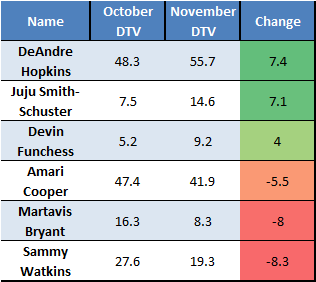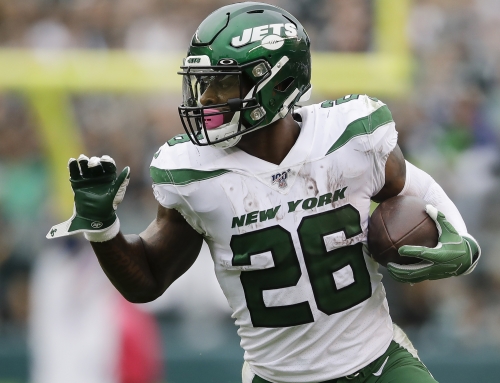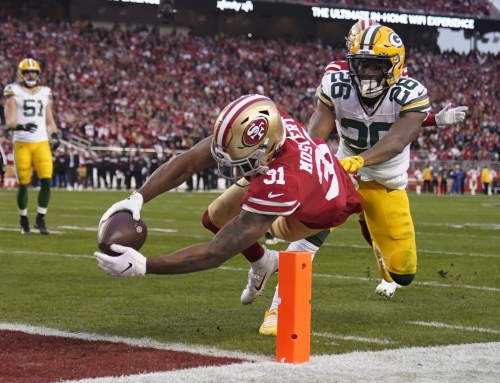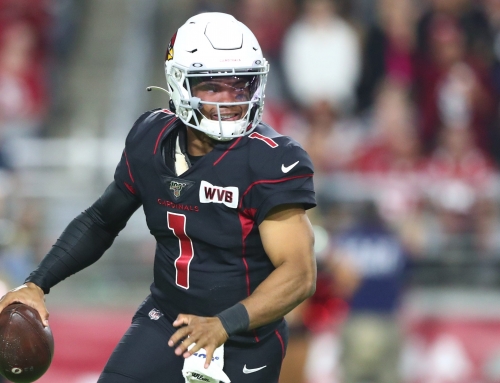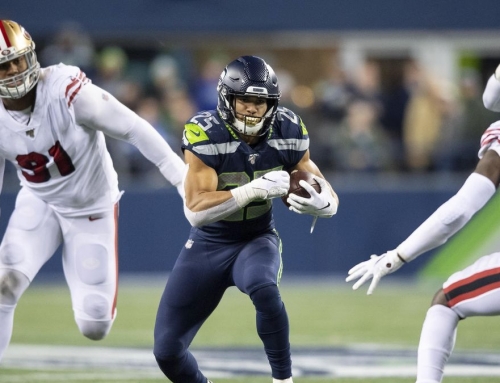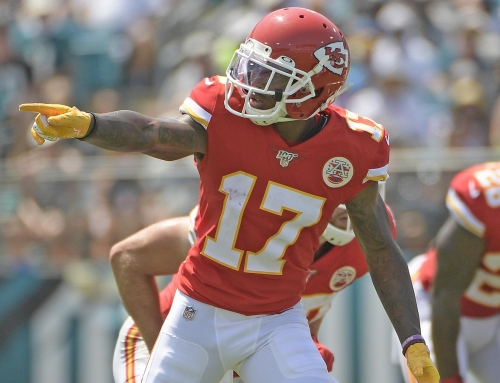Understanding and projecting player value is a key factor in dynasty fantasy football. Keeping ahead of a player’s constantly fluctuating value, whether the shift is positive or negative, can promote rapid team improvement and success. Included below are the biggest risers and fallers in Dynasty Trade Value (DTV) over the last month at the wide receiver position. Additionally, it includes brief analysis on what prompted the changes in value, as well as some brief thoughts on what to expect from each wide receiver moving forward. Unless otherwise specified, all DTVs are based on a 12-team PPR league format.
A major shift at the top has occurred at the wide receiver position. For most of the season, the top spot has been occupied by Odell Beckham Jr., with Mike Evans very close behind. Beckham is now injured and Evans has suffered a decrease in production as a result of a decrease in his target share. Both wide receivers are still elite, but DeAndre Hopkins has since reached and exceeded both Beckham and Evans’ DTV. Averaging 11.5 targets per game this season, Hopkins is only half a target per game off his 2015 rate, the year he averaged 20.6 PPR points per game. In 2016, he saw a decrease in production as a result of a sufferable season with Brock Osweiler as his quarterback. Now paired with a quarterback that understands the importance of throwing it to his best target, covered or not, Hopkins has returned to form and is averaging 21 PPR points per game this season. For the remainder of 2017, Deshaun Watson’s injury replacement, Tom Savage (maybe T.J. Yates), should follow the same game plan of heavily targeting Hopkins if the Texans want a practical chance at continued success. Beyond 2017, Hopkins will tandem with a stable quarterback that has already shown he can lead a high scoring offense and consistently provide Hopkins the volume he deserves. [Author’s Note: Hopkins is easily my favorite player in fantasy football, but I do not believe my bias towards him changes the reasons for his value increase.]
JuJu Smith-Schuster was a 2nd round pick of many 2017 rookie drafts after Corey Davis, Mike Williams, and John Ross. He was anticipated to be the third wide receiver, and likely fourth receiving option, on an established Steelers offense that had little reason to change what had made them successful. Martavis Bryant was returning from suspension and the expectation was that he would slide back into the WR2 role. There have been some kinks in the chain of what was expected to be a smooth return for Bryant. He repeatedly used social media as a carrier to take shots at Smith-Schuster, who himself has used his play on the field to act as a rebuttal. While equal in targets through seven games at 36, Smith-Schuster has been much more productive with his and leads Bryant in receptions, yards, and touchdowns. While Smith-Schuster’s upside may be capped as a result of the other weapons around him, the Steelers have an offense that can support multiple players and if Bryant does not change his attitude, the Steelers are likely to let him watch from the sidelines again while Smith-Schuster, who now trails only Davis in DTV among 2017 rookie wide receivers, continues to prove his value on the field.
Devin Funchess has seen a steady decline in DTV. He spent his 2015 rookie year in an offense where Greg Olsen the tight end was their most targeted player, followed by Ted Ginn Jr. the deep ball specialist. He battled the likes of Jerricho Cotchery and Corey Brown for targets, while the Panthers ran the ball on the majority of their plays. In 2016, the Panthers did shift to passing more than rushing, but once Kelvin Benjamin returned from injury, Cam Newton had another option that he preferred over Funchess. Olsen again led the team in targets that year, Benjamin had twice as many as Funchess, and even Ginn received more. The arrival of 2017 saw Ginn suiting up in New Orleans and Olsen succumbing to an early-season injury. Funchess was out targeting Benjamin until Benjamin was traded to Buffalo, offering Funchess a golden opportunity to capitalize. He is now competing with rookie Christian McCaffrey for targets but it is not a direct competition as they are not as similar as Funchess and Benjamin were. Funchess has risen from 2nd round rookie pick value to that of a late 1st round rookie pick and now possesses the opportunity to increase it further while he proves to become the Panthers leading receiving option.
How do we solve a problem like Amari Cooper? Cooper saw a spike after his huge performance on national television against the Chiefs. Since that game, he has returned to the early season production that has frustrated fantasy owners everywhere. Five catches for 48 yards followed by four catches for 58 yards and the end zone allergy seemingly returned. Granted, he found the end zone in Week 11 but only notched three receptions on seven targets for 28 yards. The value insulation that young receivers experience, as discussed in my previous DTV articles is keeping Cooper’s DTV high. He still is worth two to three 1st round rookie picks, but his DTV is on the decline again. The Raiders have a favorable rest of season schedule that should allow Amari to put up the production needed to finish his third consecutive season with over 1,000 receiving yards but it appears he may again fall short of double-digit touchdowns. While the overall fantasy points scored has been a disappointment in 2017, many of us are anticipating the Raiders passing game core to return to form next season. Cooper will still only be 24 years old heading into 2018 and may be coming off three straight 1,000 yard seasons which ultimately is the reason why his DTV is insulated despite poor in-season performances.
Martavis Bryant has had a whirlwind of a season thus far. Bryant returned from drug suspension this season with high expectations. There was a red flag when Smith-Schuster was drafted and Bryant took to social media to say he was replacing a teammate. The offseason brought positive reports of Bryant and how ready he was to play. The NFL season opened and he was back on the field, however, the production did not live up to the hype. Bryant averaged just 2.5 catches and 33.4 yards per game, while only scoring one touchdown. Bryant has requested a trade and again relied on social media to share his negative opinion about Smith-Schuster and as a result, the Steelers bench Bryant in Week 8. The talent is there for Bryant but he has to be on the field and focused to produce. While these off-field issues are not going to warrant an NFL suspension, they have been enough for the Steelers to game plan and win without him. As stated in the earlier Smith-Schuster paragraph, the Steelers have an offense that can support many weapons. If Bryant can straighten out all the non-football issues, he could be a productive wide receiver in a talented offense and may see his DTV rise again as a result. If he cannot figure out those issues, his DTV will continue to follow the path of his career-declining.
Sammy Watkins is the biggest loser of the month. The Rams have become one of the most explosive offenses in the NFL, but Watkins does not seem to be reaping the benefits of this offense. He continues to trail Robert Woods, Cooper Kupp, and Todd Gurley for targets and is barely out targeting tight end, Tyler Higbee. Watkins is tied for the team lead in receiving touchdowns and is leading the team in yards per reception among players that have received more than 15 targets. The usage problem remains. The Rams have a very balanced offense and when Jared Goff passes he is spreading the ball around. This is fantastic for Goff’s fantasy points and the entire Rams offense, but the shared and balanced volume is limiting Watkins’ output upside. Watkins’ DTV is now equal to a single 2018 mid 1st round rookie draft pick. He needs an improved situation, whether it is a higher market share with the Rams or as the lead receiver of another team next season. Without that change, Watkins’ DTV will not return to its previous heights alongside the top-level receivers.



